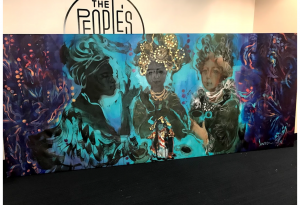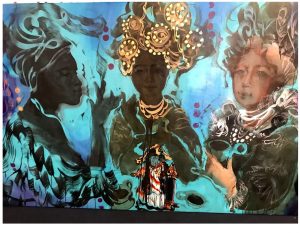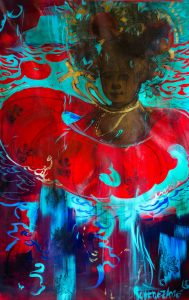La Experiencia Humana
Bella Troia
Introduction
The artist I am writing on is Scherezade Garcia. Her art theme is decolonialism and captures the essence of Hispanic life and people. The bright background colors found in her work contrast the usually darker tones of the people she paints, highlighting their background. Her work revolves around people of Hispanic origin or immigrant families in general.
Her upbringing—born in the Dominican Republic, raised in New York—is seen in many of her pieces. She shows what it felt like to be a child growing up in two different environments.
She does not only paintings but works with other mediums as well; her work involving life vests represented the dangerous journey from Puerto Rico that people make.
Analysis


This painting focuses on three women chatting over a cup of coffee. They represent the history of colonialism in the Americas through their gradually lightening skin tones as well as their attire; the woman on the left would represent Africans, the woman in the middle representing the mixed culture caused by the inclusion of African slaves and Europeans into the indigenous population, and the right one representing the increase in European expansion. The three women are connected through the coffee: the beans originating in Africa find a home in the Americas due to colonial expansion. There is a small figure of Napoleon below the middle woman; he appears defeated and has coffee spilling all over him from the woman above. By spilling this coffee and “soiling” his image, they are showing their stance against colonizers and imperialists. This piece demonstrates the history of colonialism and how that relates to heritage through the people’s eyes; it represents a sense of community through shared cultures, and coffee.

This painting, titled “American Carnaval” depicts two people dancing in traditional festival wear. The roots of Carnaval come from the Portuguese expansion into Brazil. There, colonists celebrated the Catholic tradition of Lent by enjoying in excess before they had to give it up; this reference to the church is seen by the structure and the candle lit behind the dancers. Carnaval started to evolve with the addition of tribal practices and dances introduced by the African slaves brought into the country. The dances and costumes were meant to ward off bad spirits; both of these practices are still seen in modern celebrations. The brilliant colors that are painted bring to life the clothes seen on the figures; the gold and yellows highlight key features, such as the traditional head wrap seen on one of the dancers. This piece tells a story of cultures blending to create a celebration and festival that brings all Brazilians (and other cultures) together.

In this painting, there is a young child floating in a tube. He is wearing a pair of Mickey Mouse ears, and behind those, palm trees are drawn. The contrast between the mouse ears and the palm trees shows the juxtaposition of living in the United States and visiting Disney, and the roots of his ancestry, somewhere tropical. The tube can be seen as having both positive and darker meanings. On one hand, the tube can be seen as the kind people float on in “lazy rivers”, a common attraction in theme parks. On the other hand, you can look at it like a lifesaver, representing the trek that had to be made in order to get to the United States. The latter would represent the hardships his family and people had to go through in order to guarantee that the next generations, including himself, would get to enjoy life and get the chance to go to places like Disney. Aside from those details, we can also look at his necklaces. Both are gold and appear to be traditional. One has a symbol that looks like a cross floating toward the sky. This might symbolize both the religion of his culture but also the blessings he must have had to get where he is. Overall, this image has deep meanings and represents a lot of Americans living in the US.
Application
This form of art is very important to representing and teaching about the history of Hispanic communities. They are not all the same, but they are all connected through a history of colonialism. The mixing of cultures caused by said colonialism is what has inspired many traditions. It is important to remember this history; through hardships and death inflicted upon both indigenous groups and African slaves brought to these countries, the cultures that exist today were created. This art connects the past to the future; it brings out important features of Hispanic and African heritage—the necklaces, the clothes, the head wraps, etc.—that many hold dear to their hearts and connects them to other aspects of life, including where they were transplanted to. By celebrating these cultures, we can pay homage to those who helped to keep them alive by integrating them into other festivities.
Sources:
“Súper Trópico.” Lyle O. Reitzel Gallery, https://www.lorgallery.com/new-page.
“Carnival History: Brazil Carnival.” Carnival History|Brazil Carnival|RioCarnaval.org, https://www.riocarnaval.org/brazil-carnival/carnival-history.
“Scherezade García.” Praxis Art, https://www.praxis-art.com/en/artist/scherezade-garcia/.

